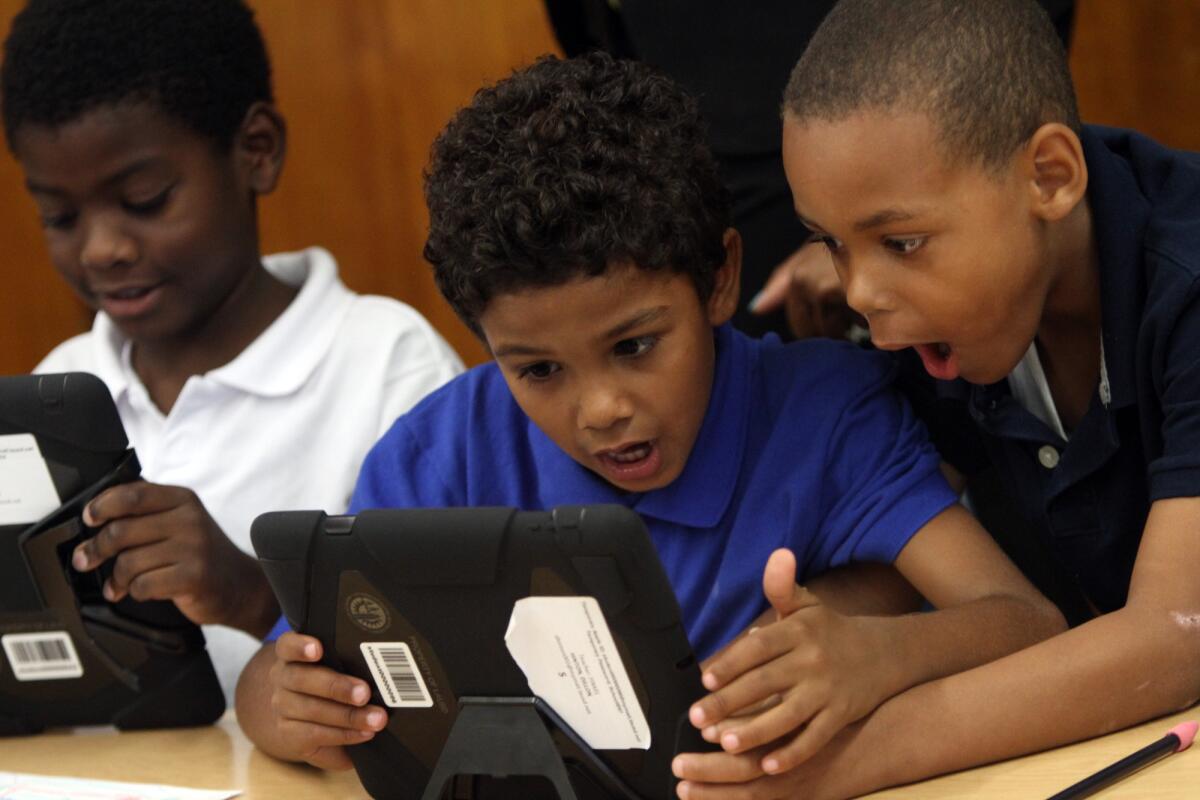When the L.A. Unified watchdog watches too closely

- Share via
If Stuart Magruder knew how to play the game, he might still have his volunteer watchdog job today.
But he just had to speak up. The arrogance, the temerity, the insolence. How dare he challenge the leadership of the Los Angeles Unified School District?
Exactly what sins did Magruder commit to get bounced last month from the district’s Bond Oversight Committee, and will rabbit-eared school board members reverse the decision at their Tuesday meeting?
Before I answer, let’s revisit the 1990s, when L.A. Unified officials wanted to raise bond money for new construction and building repairs but wisely suspected that nobody trusted them. Polling suggested voters would have a little more faith if independent citizens could keep an eye on things, and thus was born the Bond Oversight Committee.
Since 1997, voters have approved multiple bond measures totaling roughly $20 billion, about two-thirds of which has been invested in building new schools and shoring up old ones. Now a little more than $7 billion — most of it from voter-approved Proposition Q — remains to be spent.
Supt. John Deasy and the Board of Education have been salivating over the chance to get their hands on some of that money to buy a digital tablet for every student, teacher and administrator. Last year, they began purchasing tablets for classrooms, and now they would like to tap about $1 billion in bond money to finish the job.
But there have been questions about the legality and efficacy of using the bond money for portable tablets with an estimated three-year life span in a district with an estimated $50 billion or so in needed repairs and upgrades. And even more questions about whether the district has a well-considered plan, or a get-out-of-the-way compulsion to plow ahead as quickly as possible, with Deasy leading the charge.
Nobody expressed more concerns than Magruder, an architect who was appointed to the oversight committee two years ago. He thought the district’s legal justification for buying tablets was flimsy, and that was just part of his objection.
“My primary concern was that there clearly was no strong pedagogical idea behind this program, and they were literally throwing all this technology and money at teachers and students, expecting great things to happen with no proper preparation,” Magruder said.
There’s not enough space here to itemize all the issues raised at various times by Magruder and other committee members, along with members of the media.
But to name several:
Why iPads versus other, possibly less expensive tablets or laptops?
Why did the need for detached keyboards, at a cost of millions, seem to be such an afterthought?
Why did the district buy software sight unseen and only partially developed?
Why had there been so little teacher training and preparation?
Why so little consideration of who would be responsible for lost and damaged tablets?
And how useful could the tablets be if, by one legal interpretation, students wouldn’t be allowed to take them home each night?
“I’m invested in this,” said Magruder, who has two kids in L.A. Unified and got a first-hand look at the problems when his daughter’s school was included in an early phase of the iPad rollout.
Magruder didn’t find the programming engaging, compelling or linked to a larger curriculum strategy in a way that had been explained to teachers, parents or students.
“Technology doesn’t solve problems unless humans and teachers use it well,” said Magruder, who noted that the software company did manage to neatly promote itself to students with a logo on its programs.
“Not an ‘M’ for math or an ‘E’ for English, but a big ‘P’ for Pearson,” he said.
Scott Folsom, another member of the oversight committee, and Tom Rubin, the committee’s consultant, both told me they thought Magruder and others consistently raised important questions in a fair, thoughtful and constructive way, forcing the district to slow down and rethink some of its plans.
But that was Magruder’s downfall. In raising inconvenient truths, he exposed and embarrassed district officials. Three weeks ago, the petulant school board threw a little tantrum and refused to reappoint him to the committee, a move that’s being challenged by Magruder, the oversight committee and the architect association that nominated him to the board.
School board member Tamar Galatzan, one of the biggest proponents of the tablet program, has given several reasons for blocking Magruder’s reappointment. She told me she thinks the committee has done too little oversight on construction projects and too much on technology, and she argued that Magruder crossed a line on technology, questioning not just purchases but policy and curriculum.
I didn’t find any of her justifications remotely compelling.
Deasy, meanwhile, told The Times that he wasn’t taking sides. Why would he, when he’s got plenty of loyal board members to do his dirty work for him?
Voting by the oversight committee on school projects, by the way, has no binding authority on district officials. This is simply a group of 15 volunteers whose role is to represent taxpayers by keeping an eye on how their money is spent.
Getting rid of a good watchdog wasn’t just petty. Spotlighting Magruder for asking the tough questions the board should have been asking was a political blunder too. And the only way to save face, if the matter comes up for reconsideration as expected Tuesday, is to apologize to Magruder and invite him back for another term.
As Magruder reminded me, it’s an oversight committee. It doesn’t look good when those being overseen try to control who’s doing the watching.
More to Read
Sign up for Essential California
The most important California stories and recommendations in your inbox every morning.
You may occasionally receive promotional content from the Los Angeles Times.











